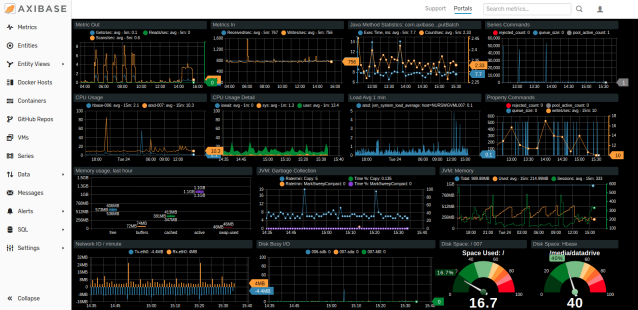Introduction
Axibase Time Series Database is a special-purpose database optimized for collecting and analyzing time-series data from IT infrastructure, industrial equipment, and financial markets.

Technology Stack
ATSD is supported on major Linux distributions in 64-bit mode.
In scale-out mode ATSD is deployed on Apache HBase on top of file systems such as Hadoop (HDFS), Amazon EMRFS, and Azure Storage.

Compute Scalability
A single-node ATSD instance can process up to 200,000 metrics per second without any loss of numeric precision. It can handle out-of-order writes and microsecond precision.
Storage Scalability
Compared to relational databases, ATSD requires up to 50 times less disk space.
Use Cases
- High-performance metrics backend.
- Consolidated statistics repository.
- Centralized monitoring system.
- Financial last trade and order statistics data store.
Components
ATSD is a modular systems which includes the following components in addition to the core storage engine:
- Rule Engine
- SQL Engine
- Portal Server
- Charts Library
- Search Service
- REST API Server
- Network API Server
- CSV Processor
Inserting Data
- Upload CSV.
- Stream CSV.
- Stream network commands via TCP/UDP.
- Stream network commands with Kafka.
- Insert data using REST API.
- Insert rows using JDBC driver.
- Use API clients or storage drivers.
- Install pre-integrated collectors/agents.
- Deploy Axibase Collectors to copy data from relational databases, plant historians, and IT infrastructure using open and proprietary protocols.
For more information about inserting data, refer to Writing Data.
Line Protocols
ATSD provides an optimized line protocol to insert high volumes of metrics with user-defined dimensions called network commands.
echo "series e:sns-001 m:temperature=15.4 m:rpm=302 t:panel=front" \
> /dev/tcp/atsd_hostname/8081
The commands can be streamed into ATSD on ports 8081/tcp, 8082/udp or uploaded to the /api/v1/command REST API endpoint.
The following protocols are supported for extended compatibility:
Schema
New entities and metrics are registered by the database automatically and support the collection of data from numerous different domain models in a single extensible schema.
The underlying tables are listed on the Settings > Storage > Database Tables page. Table schemas are self-managed by the database.
Glossary
| Name | Description |
|---|---|
Entity | Name of the object being monitored. |
Metric | Name of the numeric attribute describing the object. |
Sample | Timestamped numeric metric value, time:value. |
Series | Sequence of Samples, identified by a composite key consisting of Metric, Entity, and optional Tags. |
Tag | Custom attribute describing the Metric, Entity, or Series, and consisting of a name and a value, name:value. |
Example
The commands listed below store temperature observations for the bioreactor enclosure BR1740 located at site SVL2 in Sunnyvale, as well as room temperature at the same site.
Metadata commands contain descriptive attributes sent initially and on change.
entity e:BR1740 t:type=Bioreactor t:city=Sunnyvale t:site=SVL2
entity e:SVL2 t:type=site t:city=Sunnyvale
metric m:Temperature t:units=Celsius
Series commands carry the actual measurements and contain only the series key.
series d:2018-05-20T00:15:00Z e:BR1740 m:Temperature=70.5 t:part=enclosure
series d:2018-05-20T00:15:00Z e:SVL2 m:Temperature=25.2
series d:2018-05-20T00:16:00Z e:BR1740 m:Temperature=72.5 t:part=enclosure
series d:2018-05-20T00:16:00Z e:SVL2 m:Temperature=25.1
...
By separating metadata and time series data, each type of information is stored more efficiently. Both types of data are readily available and can be accessed in SQL queries and REST API requests.
SELECT datetime, value, entity
FROM atsd_series
WHERE metric = 'Temperature'
AND entity.tags.type = 'Bioreactor'
ORDER BY datetime
